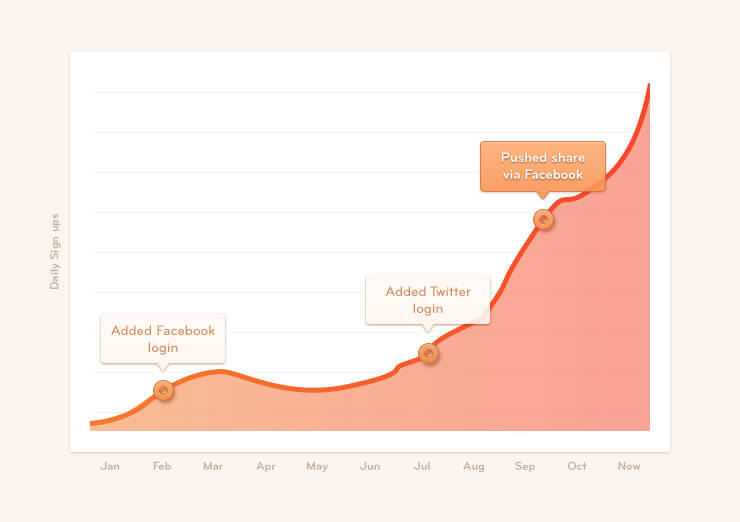Measuring Viral Distribution

Explanations are explanations, promises are promises, diagrams are diagrams… but only performance is reality.
Let’s look at how to measure social distribution. Our question here is: given a new user, how many additional new users will we get? This is what’s known as a k-factor. If k is above one, we have gone viral. Unless you are the purple cow, k is well below one, but that doesn’t mean you’ve failed. Recall that Dropbox benefitted heavily from social distribution despite not going viral. A k of 0.5 means that for every 10 users you acquire (through adwords, blogging, affiliates, etc.), you’re also getting another 5 on top which lowers your cost per acquisition.
Measuring your k-factor

You won’t get these 4 measurements from Google Analytics, so you’ll need to an engineer handy to run some queries. It’s a pretty simple formula, k=a*b*c*d with the following definitions
- a: the percentage of users who publish at least one share event per visit.
- b: the average share events per user per visit.
- c: the number of Users referred from social networks for each share event.
- d: the percentage of c that become authenticated users (i.e. in a state where they too can publish).
If you’ve just run the numbers here there’s a 99% chance that you’re disappointed. You were hoping for somewhere in the 0.5 to 1.5 range, but now you’re staring 0.02 in the face, meaning that for every fifty users you acquire, you might get one bonus one.
Improving your k-factor

There are 4 metrics you need to aggressively monitor. They are as follows:
- MUU: total number of monthly unique users.
- MAU: total number of monthly authenticated users (i.e. those that are logging in).
- DAU: total number of daily authenticated users.
- pDAU: total number of daily authenticated users who publish sharable events.
There are 3 key ratios shown here—MUU to MAU, MAU to DAU, and DAU to pDAU. Improve each of these ratios improves your k-factor. Let’s look at what we can do.
Improving MUU to MAU
In other words, how can we get more of the monthly visitors to sign-up or login? There’s 3 ways to influence this ratio:
- One-click social sign-in. This outperforms username/password on all consumer products, bar none. If you don’t have it as an option, you’re hurting yourself.
- Promote social sign-in above your standard sign-in. All things being equal, consumer sites want customers to sign in via Facebook, as this helps the product spread. Of course, do offer your own login system as an option, but only as a secondary one.
- Finally, for customers arriving from a social network, have them sign in solely through that network. e.g. if a user comes via Twitter, ask them to sign in via Twitter. It’ll be the smoothest experience (as they’re already logged in).
Improving MAU to DAU
Another way to phrase this would be: how can I increase engagement so that my users return to the site more frequently (and log in while doing so)?
We’ve covered the techniques for engaging users extensively on the blog before, but the key ideas here are automatic login (the average Facebook user is perpetually logged into Facebook, so you can automatically log them into your site based on FB authentication), useful notifications to motivate a return, and regular digests and summary mails.
Improve DAU to pDAU
How can we encourage more of our users to share? There are three key ideas here:
- Lightweight event sharing: anywhere there is activity, you should ask yourself if it is shareable. Someone pins a dress on Pinterest, makes a playlist on Spotify, likes a photo on Flickr, reads an article on the New York Times site, adds a review on Foursquare, starts a project on Dribbble, searches for photos on Spots.io… all of these are shareable events. The more you have, the better your ratio.
- Passive sharing: you can automatically share some activities, assuming you have user’s permission. For example, Spotify, LastFM, Quora, etc. all passively share lots of user activities, which guarantees a pDAU to DAU ratio of 1:1. Every single time I launch Spotify, I’m sharing to Facebook. When you can remove a ratio from the equation, it significantly reduces your challenges.
- Share from anywhere: a common mistake here is to only permit sharing from your web app. Activities should be shareable any time they are performed—not just through a web application. This means that in the rush to sleek mobile design, you need to be careful about cutting off your call-to-actions for sharing.
Concluding thoughts
Spamming doesn’t work. It’s bad for business. Sharing without permission, sharing non-user activity on their behalf, spamming friend lists, sending irrelevant push notifications, all of these are short-term wins, but in the long term you lose absolutely everything. Your app will be blocked, your users will cancel, and your product will be pulled from the App Store.
Viral distribution accelerates your logical conclusion. This is why you have to solve retention first. If you have no compelling reason to return, then going viral won’t help you—it’ll just speed up the process at which you die. Bill Bernbach famously said “Nothing kills a bad product faster than good advertising. Everyone tries the thing and never buys it again.”. The same is true for good distribution.
Social distribution brings a new wave of growth which both consumer and business-to-business products can benefit from. But if your product sucks then it just brings the lethal injection.
If you like this post, please share it…







